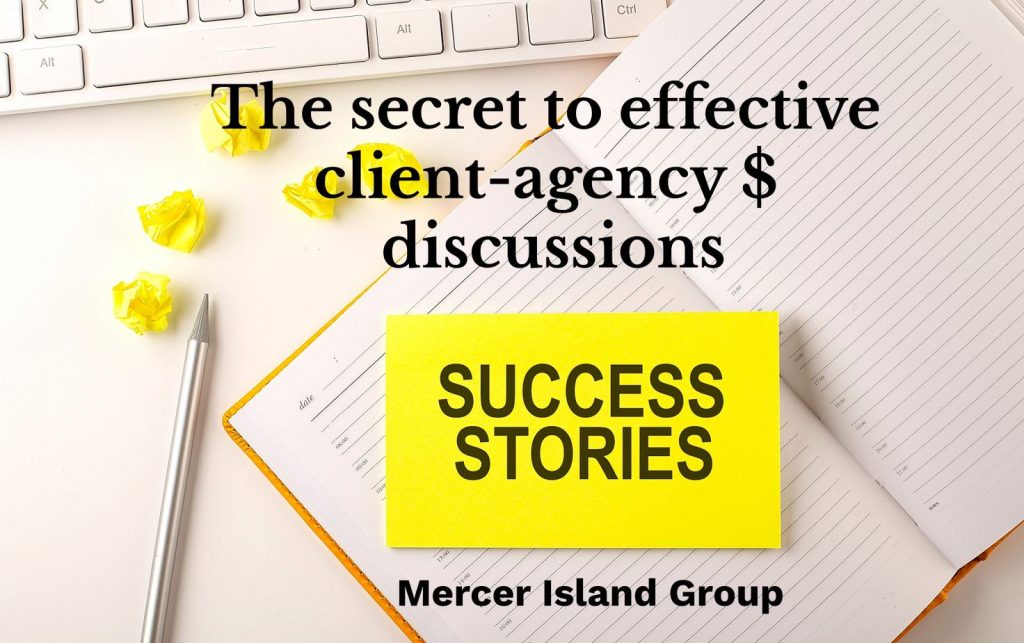Very few clients or agency people like to discuss money. At best it’s a necessary evil, and at worst it is nerve wreaking and painful.
And maybe because of what seems like the inherent stress involved in these discussions, the norm is to do this poorly. Clients often expect far more than they can afford. Agencies often submit a list of tactics along with a cost estimate or a spreadsheet full of staff time and hours associated with a scope. Neither of the teams is getting what they need.
There is a better way.
The secret to successful client-agency financial discussions is to change the conversation. Rather than a focus on the tactics delivered for a specific cost, turn the discussion into to a mutual story of success.
A story of the client’s and agency’s mutual success.
Start with the client’s business goals and issues. By agreeing on which of the client’s specific business objectives and issues the agency can help address, the teams are ready to create the success story of how those goals can be achieved.
This is a fundamental step as it brings the conversation back to where it should always begin: the business. Clients do not invest in marketing or agencies for fun. They invest in order to positively impact their business. By focusing the start of any scoping discussion here, the agency is talking the client’s language and the client is specifically declaring what help they need.
For example, maybe the client needs to increase awareness by +5%. Their modeling indicates that with that increase, their inhouse performance team can deliver the lower funnel performance necessary to achieve the company’s sales growth target of +2%.
With alignment on that awareness goal, the client and agency are ready for a productive discussion about how to achieve the awareness goal.
Link the client’s goals to specific strategies. Goals are great, but they don’t accomplish themselves. Important goals need to be linked to strategies that can impact the goal. Either party can take the lead on this step; the key is for the client and agency to be solidly committed to the strategies needed.
In our example, perhaps the strategy the client and agency agree upon is a broad reach awareness campaign.
Identify the tactics that best fit the agreed upon strategies.
With the parties strategically aligned, it is time for the agency to recommend tactics that address the agreed upon strategy.Perhaps the tactics needed are a brand campaign with TV, video, digital and social assets.
Define the specific agency deliverables needed. The agency now needs to identify the specific deliverables they are signing up for – moving from tactical areas to very specific finished work.
The deliverables necessary in our example may include a campaign strategy, campaign creative platform and specific assets (such as three 30-second videos, three 15-second videos, and weekly paid social posts).
In an ideal working relationship the client and agency would have had very specific discussions by this point about how the expected or proposed deliverables will help the client achieve their business goals.
Define the investment needed. With alignment regarding the deliverables necessary for success, the next step is for the agency to share the cost of the agency’s contribution to the client’s goals – what it will cost for the agency to deliver the work identified.
The conversation does not end here.
Recap how the investment helps the client achieve their goals. The critical final step brings the discussion full circle: a shared understanding of how the proposed agency investment and the deliverables resulting from that investment will help the client achieve their goals.
This is, in effect, the client and agency developing a mutual success story. The client expects to achieve their business goals and the agency is fairly compensated for that work.
This mutual success story – created together – is the key to budget and scope harmony.
Of course, this approach does not insulate the agency from the need to be competitive with the marketplace, or the client needing to pay a fair amount for the valuable work the agency creates. Yet, to be clear, that reality is easier to lean into when clients and agencies create mutual success stories about their investments, work and returns.
Mutual success stories are the ticket to better client-agency engagement and success.
